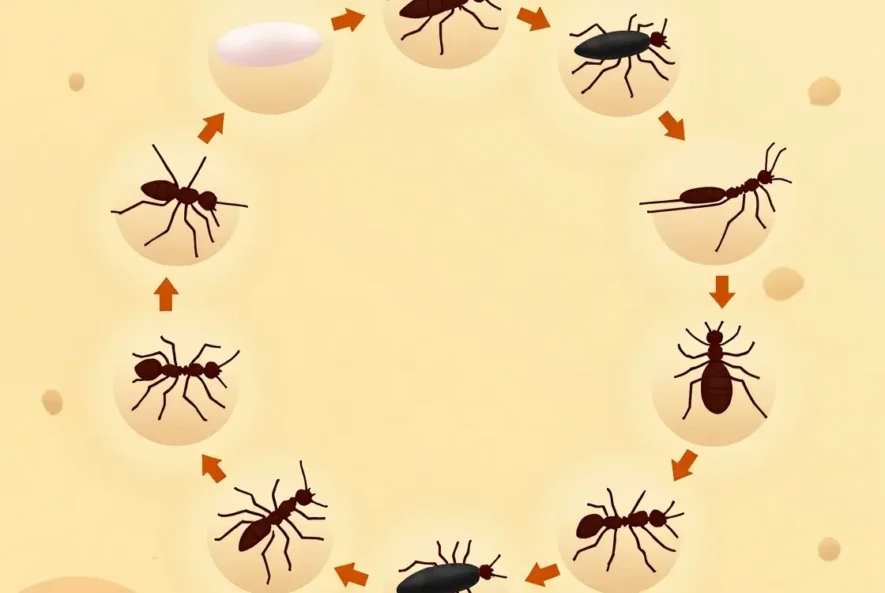
Understanding the Life Cycle of Common Saudi Arabian Pests
Pests are a common problem in homes and businesses across Saudi Arabia, particularly in Dammam, Ras Tanura, Al Khobar, and Al Jubail. Understanding the life cycle of these pests is crucial for effective pest control. Whether it’s the creepy crawlers like ants or the buzzing insects such as mosquitoes, each pest has its unique life cycle that plays a significant role in how and when it can infest your home.
In this blog, we’ll delve into the insect life cycle, how it affects pest control, and how you can use this knowledge to keep your property pest-free year-round.
What is the Insect Life Cycle?
The insect life cycle refers to the series of developmental stages an insect undergoes from egg to adulthood. The life cycle differs depending on the species, and understanding this cycle is key to targeting the pest at the right stage for the most effective control.
Generally, insects go through one of two types of life cycles: complete metamorphosis or incomplete metamorphosis. Each of these processes involves different stages, and understanding them can help in effectively controlling pests.
1. The Complete Metamorphosis Life Cycle (4 Stages)
Insects that undergo complete metamorphosis have four distinct stages in their life cycle:
- Egg – This is the first stage where an insect begins life. The eggs are laid by the adult female and will hatch into larvae.
- Larvae – The larvae stage is typically the longest. During this phase, the insect is growing rapidly and feeding. Common pests like mosquitoes and flies spend a significant amount of time in this stage, which can cause problems as they infest your home.
- Pupa – The insect enters the pupa stage where it undergoes transformation. It doesn’t feed in this phase, and it is during this stage that the insect changes into its adult form.
- Adult – Once the metamorphosis is complete, the insect becomes an adult. It is in this stage that insects reproduce, continuing the cycle.
Common pests like flies, beetles, and mosquitoes follow a 4-stage life cycle. Understanding the timing of these stages helps in identifying the best times for treatment.
2. Incomplete Metamorphosis Life Cycle (3 Stages)
Insects that undergo incomplete metamorphosis have three stages in their life cycle:
- Egg – Like complete metamorphosis, insects begin life as eggs. The eggs hatch into nymphs instead of larvae.
- Nymph – The nymph is a juvenile version of the adult insect, and unlike larvae, it looks similar to the adult but lacks fully developed wings. As the nymph matures, it molts several times until it becomes an adult.
- Adult – The final stage is the fully developed insect, which is capable of reproduction. Insects like cockroaches, grasshoppers, and termites follow an incomplete life cycle of insects.
These pests can often be seen earlier in the cycle since the nymphs start to appear similar to the adult form. Understanding this can help you treat the infestation earlier before it fully develops.
Common Saudi Arabian Pests and Their Life Cycle
In Saudi Arabia, some of the most common pests you may encounter include cockroaches, termites, flies, mosquitoes, and wasps. Here’s how their life cycles influence when and how they cause issues:
- Cockroaches: These pests follow the incomplete metamorphosis cycle. Their life cycle involves eggs, nymphs, and adults. Cockroaches breed quickly, so understanding their rapid life cycle helps in controlling their spread.
- Termites: Termites, like many insects in Saudi Arabia, follow a complete metamorphosis cycle with eggs, larvae, pupa, and adult stages. Understanding the timing of termite life cycles is crucial for effective pest control, as they can cause extensive damage to wooden structures.
- Mosquitoes: These insects undergo complete metamorphosis. Their life cycle is heavily dependent on water sources, and larvae can survive in stagnant water for weeks before they mature into adult mosquitoes.
- Wasps: Wasps also follow a complete metamorphosis cycle. The queen wasp starts a new colony each year, laying eggs that hatch into larvae and eventually mature into new wasps.
Pest Control Tips Based on the Insect Life Cycle
Now that we understand how pests in Saudi Arabia go through their life cycles, let’s explore how you can use this knowledge for effective pest control in Dammam, Ras Tanura, Al Khobar, and Al Jubail:
- Target Pest Stages: Use pest control methods at key stages in the insect’s life cycle. For example, applying treatments during the larvae or nymph stages is most effective, as they are more susceptible to insecticides than adults.
- Seasonal Control: Many insects are most active during certain times of the year, so adjust your pest control strategy accordingly. In Saudi Arabia, pests are often most active during the warmer months, so seasonal pest control is important.
- Identify Entry Points: Pests like cockroaches and termites often enter through small cracks. Regular inspections and sealing potential entry points can help reduce the risk of infestations.
Conclusion
Understanding the life cycle of insects is crucial for effective pest control in Saudi Arabia, especially in cities like Dammam, Ras Tanura, Al Khobar, and Al Jubail. By knowing when pests are most vulnerable, you can implement targeted control measures at the right time. Whether you’re dealing with cockroaches, mosquitoes, or termites, understanding their life cycle will make your pest control efforts more effective and long-lasting.
If you’re dealing with a pest problem and want professional assistance, reach out to our pest control experts today. We can help you protect your home or business from the pests that thrive in Saudi Arabia.
FAQs About the Insect Life Cycle and Pest Control
Q1: What is the complete life cycle of a pest?
The complete life cycle of a pest includes four stages: egg, larvae, pupa, and adult. Insects like mosquitoes, flies, and beetles go through this cycle.
Q2: What are the 4 stages of the insect life cycle?
The four stages of the insect life cycle are egg, larvae, pupa, and adult.
Q3: What is the difference between disinfection and pest control?
Disinfection refers to cleaning surfaces to kill germs and bacteria, while pest control targets the elimination or prevention of pests through various methods like traps, sprays, or fumigation.
Q4: What time of year are pests most active?
Pests are generally most active during the warmer months, especially in regions like Saudi Arabia. However, different pests have varying peak seasons, so it’s important to monitor and control them year-round.

